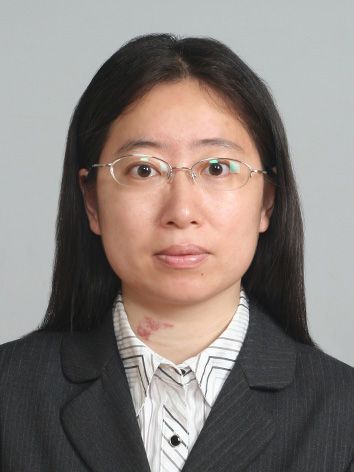

研究方向
透射电子显微学的高熵合金精细结构表征
高熵合金力学行为的原位透射电子显微学分析
教育经历
2009/04-2012/03埼玉工业大学材料科学与工程博士
2005/09-2007/12国防科技大学材料科学与工程硕士
2001/09-2005/07郑州大学环境工程学士
工作经历
2022/03 至今北京科技大学新金属材料国家重点实验室副研究员
2019/04-2021/11芝浦工业大学材料科学与工程学院副教授
2017/10-2019/03北陆先端科学技术大学院大学纳米材料技术中心助教
2015/04-2017/09北陆先端科学技术大学院大学材料系博士后
2013/04-2015/03东京工业大学量子纳电子研究中心博士后
2012/04-2013/03日本国立材料研究所透射电子显微镜中心博士后
论文著作
[1]C. Liu, J. Zhang, S. G.Ramaraj,X. Zhang, M.Muruganathan,H. Mizuta and Y.Oshima, Current effect on suspended graphene nanoribbon studied usingin-situ transmission electron microscopy.Applied Surface Science573, 151563, 2022.
[2]C. Yang,S. Tao,N. Huang,X. Zhang,J. Duan,R. Makiura,S. Maenosono, Heteroatom-doped carbon electrocatalysts derived from nanoporoustwo-dimensional covalent organic frameworks for oxygen reduction and hydrogen evolution. ACS Applied Nano Materials6, 5481-5488, 2020.
[3]C. Liu, J. Zhang, X. Zhang, M Muruganathan, H. Mizuta and Y. Oshima, In-situ electrical conductance measurement of suspended ultra-narrow graphene nanoribbons observed via transmission electron microscopy. Nanotechnology32, 025710, 2020.
[4]C. Liu, J. Zhang, M Muruganathan, H. Mizuta, Y. Oshima and X. Zhang, Origin of nonlinear current-voltage curves forsuspended zigzag edge graphene nanoribbon. Carbon165, 476−483, 2020.
[5]C. Yang, S. Maenosono, J. Duan and X. Zhang, COF derived N, P co-doped carbon as a metal-free catalyst for highly efficient oxygen reduction reaction, ChemNanoMat, 5, 957-963, 2019.
[6]Q. Di, X. Zhu, J. Liu, X. Zhang, H. Shang, W. Chen, J. Liu, H. Rong, M. Xu and J. Zhang, High-performance quantum dots with synergistic doping and oxide shell protection synthesized by cation exchange conversion of ternary-composition nanoparticles. The journal of physical chemistry letters10(10), 2606−2615, 2019.
[7]X. Zhu, H. Rong, X. Zhang, Q. Di, H. Shang, B. Bai, J.J. Liu, J. Liu, M. Xu, W. Chen and J. Zhang, Compressive surface strained atomic-layer Cu2O on Cu@Ag nanoparticles, Nano Research, 12(5), 1187-1192, 2019.
[8]Z. Chen, Q. Wang, X. Zhang, Y. Lei, W. Hue, Y. Luo, Y. Wang, N-doped defective carbon with trace Co for efficient rechargeable liquid electrolyte-/all-solid-state Zn-air batteries. Science Bulletin63, 548−555, 2018.
[9]Q. Xu, Y. Tang, X. Zhang, Y. Oshima, Q. Chen and D. Jiang, Template conversion of covalent organic frameworks into 2d conducting nanocarbons for catalyzing oxygen reduction reaction. Advanced Materials30, 1706330, 2018.
[10]M. E. Schmidt, X. Zhang, Y. Oshima, L. T. Anh, A. Yasaka, T. Kanzaki, M. Muruganathan, M. Akabori, T. Shimoda and H. Mizuta, Interaction study of nitrogen ion beam with silicon, Journal of Vacuum Science & Technology B35, 03D101, 2017.
[11]T. Hamaoka, C. Y. Jao, X. Zhang, Y. Oshima and M. Takeguchi, Three-dimensional characterization of Guinier–Preston zones in an Al–Cu alloy using depth-sectioning technique, Microscopy66, 78−88, 2017.
[12]Y. Oshima and X. Zhang, Phase mapping obtained by transport of intensity equation,Microscopy (Japanese) 52(1), 19−23, 2017.
[13]X. Zhang and Y. Oshima, Atomic resolved phase map of monolayer MoS2 retrieved by spherical aberration-corrected transport of intensity equation, Microscopy65(5), 422−428, 2016.
[14]S. Kim, W. Cho, X. Zhang, Y. Oshima and J. W. Choi, A stable lithium-rich surface structure for lithium-rich layered cathode materials. Nature Communications7, 13598, 2016.
[15]X. Zhang and Y. Oshima, Experimental evaluation of spatial resolution in phase maps retrieved by transport of intensity equation, Microscopy64(6), 395−400, 2015.
[16]X. Zhang and Y. Oshima, Practical procedure for retrieval of quantitative phase map for two-phase interface using the transport of intensity equation, Ultramicroscopy158, 49−55, 2015.
[17]Z. Chu, R. He, X. Zhang and X. Li, The production of polycarbosilane-derived porous carbon fibers, Carbon 50, 2666−2674, 2012
[18]X. Zhang, M. Takeguchi, A. Hashimoto, K. Mitsuishi, M. Tezuka and M. Shimojo, Improvement of depth resolution of ADF-SCEM by deconvolution: Effects of electron energy loss and chromatic aberration on depth resolution, Microscopy and Microanalysis18, 603−611, 2012.
[19]X. Zhang, M. Takeguchi, A. Hashimoto, K. Mitsuishi, P. Wang, P. D. Nellist, A. I. Kirkland, M. Tezuka and M. Shimojo, Three-dimensional observation of SiO2 hollow spheres with a double-shell structure using aberration-corrected scanning confocal electron microscopy, Journal of Electron Microscopy61(3), 159−169, 2012.
[20]X. Zhang, M. Takeguchi, A. Hashimoto, K. Mitsuishi and M. Shimojo, Application of scanning confocal electron microscopy to nanomaterials and the improvement in resolution by image processing, Mater. Science Forum675−677, 259−262, 2011.
[21]Z. Chu, R. He, X. Zhang, H. Cheng, X. Li and Y. Wang, Hydrogen adsorption properties of polymer-derived nanoporousSiCx fibers, International Journal of Hydrogen Energy35, 3165−3169, 2010.
[22]Z. Chu, R. He, X. Zhang, Z. Jiang, H. Cheng, Y. Wang and X. Li, Fabrication of porous SiCy (core)/C (shell) fibres using a hybrid precursor of polycarbosilane and pitch, Carbon48, 2106−2122, 2010.
[23]R. He, X. Zhang, Z. Chu, X. Li, Y. Wang, Effect of pyrolysis temperatures and precursor treatments on hydrogen adsorption and storage properties of SiC fibers, Rare Metal Materials and Engineering36(z1), 383−386, 2007.
[24]R. He, X. Li, Z. Chu, Y. Si, X. Zhang, Development of automotive fuel gas storage technology and adsorption storage materials, Materials Review21(6), 75−79, 2007.
科研项目
[1]日本学术振兴机构科研费-若手研究,基于器件微型化的纳米热电性能尺寸/晶体取向依赖性的原位透射电子显微镜研究(19K15382),主持,2019/04-2022/03
[2]芝浦工业大学科研启动项目,电子束辐照法对石墨烯的可控纳米加工,主持,2019/04-2020-03
[3]池田科学技术振兴财团年度研究助成,悬浮石墨烯纳米带的边界结构及其输电性能测试(0291068-A),主持,2017/04-2018/03
[4]泉科学技术振兴财团年度研究助成,基于二维原子层薄膜的简易纳米器件的输电性能评价(H28-J-058),主持,2016/10-2017/09
[5]日本科学协会笹川科学研究助成,使用纳米狭缝电极的TEM专属样品台的开发及二维纳米材料输电性能测试的实现(28-226),主持,2016/04-2017/02
[6]JST战略创造研究推进事业CREST项目,Nano-in-Macro phase interface and mass transfer nanocycle(114209-JPMJCR11C4),参与,2011/12-2015/03
[7]JSPS国际交流事业二国间交流事业项目,共聚焦扫描透射电子显微镜获取原子分辨率断层图像的研究(1001026),参与,2009/04-2011/03